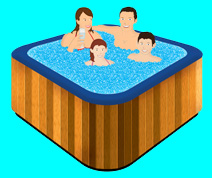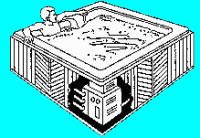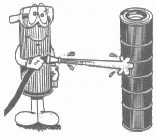WATER CHEMISTRY FOR YOUR HOT TUB OR SPA
There are 2 goals of proper water chemistry: Protecting the bathers and protecting the equipment.
Protecting the
bathers:
 Keep
the water clean and sanitized by maintaining the bromine or chlorine
within their recommended levels: Keep
the water clean and sanitized by maintaining the bromine or chlorine
within their recommended levels:
- Bromine = 2.8-3.5 ppm
- Chlorine = 0.8-1.5 ppm
(If your spa is equipped with
an ozone generator, you may choose to maintain the chlorine or
bromine at the lower end of their ranges.)
Shocking the water with a non-chlorine
shock oxidizes the water removing organic waste, helping the
sanitizer work more effectively and removes odors. One teaspoon
of shock is recommended at the end of the day of use.
Maintain the pH between 7.2-7.8.
In this range bathers are comfortable, the spa surface and equipment
are protected and the sanitizers perform efficiently.
Drain and refill the spa every
3-6 months.
Protecting the
equipment:
 As already stated, maintain the
pH between 7.2-7.8. This range ensures that the spa surface and
equipment are protected and the sanitizers perform efficiently.
Clean the filter 2-4 times a
month, soak the filter in a filter or cartridge cleaning solution
every 3 months and replace it every 12-18 months to ensure proper
water flow so as not to damage the spa equipment.
Drain and refill the spa every
3-6 months, once the tub is full of fresh water, a metal remover
is recommended to remove excess metals from the water that may
damage the heater or pump seal.
Test the water:
As already stated, maintain the
pH between 7.2-7.8. This range ensures that the spa surface and
equipment are protected and the sanitizers perform efficiently.
Clean the filter 2-4 times a
month, soak the filter in a filter or cartridge cleaning solution
every 3 months and replace it every 12-18 months to ensure proper
water flow so as not to damage the spa equipment.
Drain and refill the spa every
3-6 months, once the tub is full of fresh water, a metal remover
is recommended to remove excess metals from the water that may
damage the heater or pump seal.
Test the water:
 To ensure that the spa water
is properly balanced and safe.
To ensure that the spa water
is properly balanced and safe.
- To detect and avoid problems.
Liquid test kits or test strips,
you decide:
- Liquid test kits provide a more
accurate measurement of sanitizer and pH.
- Test strips are more convenient
and quick, however, their accuracy is debatable.
Monitor the sanitizer level by
testing 1-2 times a week. If the levels are not in the proper
range, adjust as necessary.
Maintain the pH level between
7.2 and 7.8. If the pH is low, add a pH increaser. If the pH
is high, add a pH decreaser, following the directions on the
bottles.
Cleaning the
Filter:
 We recommend that you clean your
filter 2-4 times per month with your garden hose.
We recommend that you clean your
filter 2-4 times per month with your garden hose.
- Remove the filter cartridge from the
spa's filter housing.
- Use a garden hose with a straight flow
nozzle to wash down the filter element. Work from the top down,
holding the nozzle at a 45 degree angle and wash all the pleats
with emphasis between pleats.
- Rinse until all dirt and debris are
gone.
- Place back in the spa's filter housing.
Every 3-4 months clean the filter
with a filter cartridge cleaning solution such as Filter
Clean to break down the perspiration, suntan lotions and
other oils present in the water.
Energy/Tub Saving
Tips:
To reduce energy consumption
on your spa and prolong the life of the spa, here are some simple
tips.
 Keep lid closed when not in use.
This keeps debris out of the tub, prevents the sun from cooking
the tubs surface and the components on the top of tub, such as
the topside and control knobs. The sun will discolor the knobs,
cause the topside to darken to make the LED/LCD display unreadable
and can cause diverter and on/off valves to shrink and cause
the caps to blow off once the pump(s) come on. Keeping the lid
closed also eliminates loss of heat in the cooler weather which
means the heater works less prolonging its life and reducing
the electricity usage of the spa.
Keep lid closed when not in use.
This keeps debris out of the tub, prevents the sun from cooking
the tubs surface and the components on the top of tub, such as
the topside and control knobs. The sun will discolor the knobs,
cause the topside to darken to make the LED/LCD display unreadable
and can cause diverter and on/off valves to shrink and cause
the caps to blow off once the pump(s) come on. Keeping the lid
closed also eliminates loss of heat in the cooler weather which
means the heater works less prolonging its life and reducing
the electricity usage of the spa.
 When the lid is closed, turn
off air valves*. These valves pull air into the water from outside
or under the tub. This air is pulled in anytime the pump(s) run
and the valves are open. The air in the winter is cooler than
the water causing the water to drop in temperature and making
the heater come on more. In the summer the air valves pull in
hotter air causing the tub to increase in temperature and possibly
go into an overheat situation. The popping air bubbles can also
shorten the lids lifespan by throwing chemicals from the water
onto the underside of the lid causing the lid to become rough,
crack, shrink and destroy the foam inside. These effects can
cause the lid to become heavy with water weight or dry out and
become light, flimsy or warped causing a poor seal to the tubs
surface allowing heat to escape and debris to get in.
*If you have a forced
air system, common on some Maax and Coleman Spas, do not turn
off the air valves. By doing so you will blow the diaphragms
in the venturi caps causing a loud whistling sound and loss of
air pressure in the tub.
When the lid is closed, turn
off air valves*. These valves pull air into the water from outside
or under the tub. This air is pulled in anytime the pump(s) run
and the valves are open. The air in the winter is cooler than
the water causing the water to drop in temperature and making
the heater come on more. In the summer the air valves pull in
hotter air causing the tub to increase in temperature and possibly
go into an overheat situation. The popping air bubbles can also
shorten the lids lifespan by throwing chemicals from the water
onto the underside of the lid causing the lid to become rough,
crack, shrink and destroy the foam inside. These effects can
cause the lid to become heavy with water weight or dry out and
become light, flimsy or warped causing a poor seal to the tubs
surface allowing heat to escape and debris to get in.
*If you have a forced
air system, common on some Maax and Coleman Spas, do not turn
off the air valves. By doing so you will blow the diaphragms
in the venturi caps causing a loud whistling sound and loss of
air pressure in the tub. |
|
|
|
|
|
|
|
|
|
|
|

 Keep
the water clean and sanitized by maintaining the bromine or chlorine
within their recommended levels:
Keep
the water clean and sanitized by maintaining the bromine or chlorine
within their recommended levels:







Keep the water clean and sanitized by maintaining the bromine or chlorine within their recommended levels: